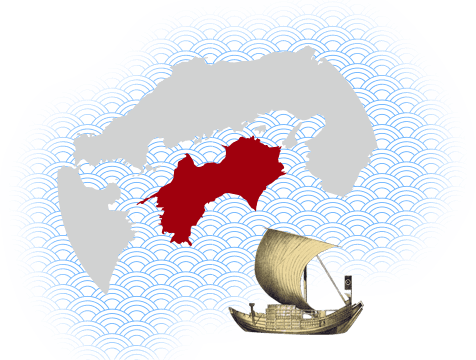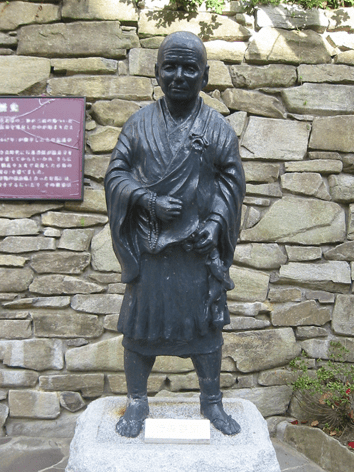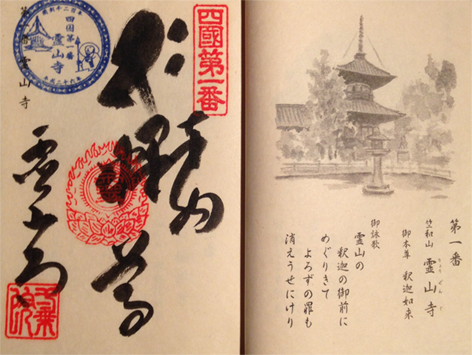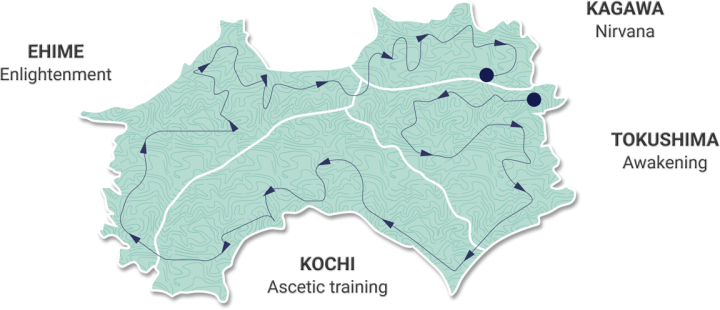Origins of the Shikoku Pilgrimage
Home » The Shikoku Pilgrimage » Origins of the Shikoku Pilgrimage
Origins of the pilgrimage
The history of the pilgrimage starts with the nature of the island of Shikoku itself.
Back in the mists of time, Shikoku was a wild, frontier place, separated from the rest of Japan by a turbulent and hazardous sea that sunk ships. It was also infested with pirates. Early Buddhism held that the entrance to heaven was to be found in the wild southern borderlands across the sea, which corresponded very well to Shikoku. And just as today’s visitors to Shikoku are pushing the boundaries of travel in Japan, pilgrims setting out to complete their circuit of Shikoku have always been seen as taking a daring step towards heaven, one step short of death.

Starting around 1,300 years ago, this dangerous but promising place attracted a succession of three unorthodox religious zealots the last of whom, Kukai, is regarded as the founder of the pilgrimage. But his two predecessors, En no Gyoja and Gyoki really laid the groundwork.
En (634-701) was an ascetic and mystic. He’s traditionally regarded as the founder of Shugendo, a religion combining traditional Shinto with imported Buddhism, practiced through demanding training in mountain and coastal areas. Against the edicts of the central government, he preached to commoners and practised his mystical discipline in Shikoku.
Gyoki (668-749) similarly defied the regulations prohibiting activities by priests outside their monastic compounds, traveling around the country preaching Buddhism to commoners and helping the poor. Of the 88 pilgrimage temples, Gyoki is said to have established 37. Gyoki who lived until 749, 25 years before Kukai was born in 774, was originally the subject of many of the myths and legends later attributed to Kukai.
Kukai (774-835) was born in Shikoku at Zentsu-ji. After studying in China, he returned to Japan and founded the Shingon or the “True Word” school of Buddhism. Like his predecessors En and Gyoki, he carried out ascetic practice in the wild places of Shikoku and performed good works as well as founding a few temples.
In Kukai’s time there was no fixed pilgrimage route around Shikoku. Before then, national temples (Kokubun-ji) were established and visited by pilgrims. Kukai established two or possibly more temples and after his death, temples were built at significant sites from his personal history. These various temples gradually coalesced into the pilgrimage, known as the Henro.
Pilgrims travelled to Shikoku to make the pilgrimage for various reasons such as atoning for sins, seeking a cure for illness, in search of a place to live as a vagabond, or in pursuit of enlightenment. The people of Shikoku gave their uninvited visitors a guarded welcome, hoping to gain karmic benefits from helping them, and from the less pious hope that none of them would die on their doorstep. These pilgrims came to be known as Ohenro-san.

The tradition of the temple stamps probably arose from the restrictions on travel in the Edo period, when the movement of ordinary people was tightly regulated by a system of guard posts on major roads. Pilgrims had to obtain travel permits, follow the main paths, and pass through the guard posts within a certain time limit. The book of temple stamps represented proof of passage and a passport of sorts.

The concept of the four domains of Shikoku as the four stages of attaining Buddha-hood, awakening, ascetic training, enlightenment, and nirvana, is a recent invention promoted by the organization formed by the 88 temples.

In more modern times, the travel options have expanded from striding around the trail on foot to include cars, buses, bicycles and motorbikes. While people still continue to walk in ever increasing numbers, many pilgrims now join bus or taxi tours. Whichever means they choose, the people of Shikoku regard these visitors as Ohenro-san, bona fide pilgims on the Henro.
Shikoku Tours was the first organization in history to offer tours of the pilgrimage by rental car and taxi for foreign visitors. Pilgrims from Australia were the first to take the self-driven tour in 2014.
Our Pilgrimage Tours

Experience the most beautiful and interesting temples of the Shikoku Pilgrimage in seven days.

A tour for families or friends, staying in the most characterful kominka and ryokan of Shikoku.

Visit the most beautiful and interesting temples of the Shikoku Pilgrimage and walk the toughest trails.
